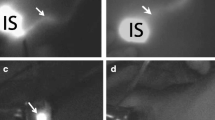Abstract
Background: The objectives of this study were, first, to define the preoperative criteria for using solely the blue dye method and, second, to decrease its operator dependence in predicting axillary lymph node status.
Methods: Two hundred fifty-three women consecutively identified with operable breast cancer underwent sentinel lymph node (SLN) detection by the patent blue dye method followed by completion axillary lymph node dissection. A standard pathological examination was performed for all SLN. Then, a pathological color quality assessment (PCQA), which checked for the presence of the blue dye, was performed on the paraffin blocks of the nonmetastatic SLN. Six preoperative identifiable variables likely to influence the detection rate were examined.
Results: The surgical detection (sd) rate was 84% (213 of 253) and the PCQA rate was 73% (185 of 253). Only breast size (sd, P = .0005; PCQA, P = .0007) and body mass index ≤30 (sd, P = .005; PCQA, P = .0007) were significant for SLN identification. Multivariate analysis revealed two independent factors influencing SLN identification: breast size (sd, P = .0001; PCQA, P = .002) and the timing of injection—injection prior to lumpectomy (sd, P =.04).
Conclusions: The optimal patient features for identifying the SLN by the patent blue dye method are small or medium-sized breasts, low body fat, and that the procedure is carried out prior to tumor excision. The PCQA offers a useful second assessment of the surgically removed SLN, introducing an independent element of quality control.
Similar content being viewed by others
REFERENCES
Cody III HS. SLN mapping in breast cancer. Oncology 1999; 13: 25–43.
Giuliano AE, Kirgan DM, Guenther JM, Morton DL. Lymphatic mapping and sentinel lymphadenectomy for breast cancer. Ann Surg 1994; 220: 391–401.
Giuliano AE, Jones RC, Brennan M, Statman R. Sentinel lymphadenectomy in breast cancer. J Clin Oncol 1997; 15: 2345–50.
Flett MM, Going JJ, Stanton PD, Cooke TG. Sentinel node localization in patients with breast cancer. Br J Surg 1998; 85: 991–3.
Guenther JM, Krishnamoorthy M, Tan LR. Sentinel lymphadenectomy for breast cancer in a community managed care setting. Cancer J Sci Am 1997; 3: 336–40.
Guenther JM. Axillary dissection after unsuccessful sentinel lymphadenectomy for breast cancer. Am Surg 1999; 65: 991–4.
Haigh PI, Hansen NM, QiK, Giuliano AE. Biopsy method and excision volume do not affect success rate of subsequent sentinel lymph node dissection in breast cancer. Ann Surg Oncol 2000; 7: 21–7.
Rodier JF, Janser JC. Surgical technical details improving sentinel nodes and breast cancer. Oncology Rep 1997; 281–3.
Nos C, Bourgeois D, FréneauxP, Zafrani B, Salmon RJ, Clough KB. Individualisation du ganglion sentinelle en cas de cancer du sein. Experience de l’Institut Curie. Bull Cancer 1999; 86: 580–4.
Krag DN, Weaver DL, Ashikaga T, et al. The sentinel node in breast cancer. A multicenter validation study. N Engl J Med 1998; 339: 941–6.
Veronesi U, Paganelli G, Viale G, et al. Sentinel lymph node biopsy and axillary dissection in breast cancer: results in a large series. J Natl Cancer Inst 1999; 4: 368–73.
Borgstein PJ, Pijpers R, Comans EF, vanDiest PJ, Boom RP, Meijer S. Sentinel lymph node biopsy in breast cancer: guidelines and pitfalls of lymphoscintigraphy and gamma probe detection. J Am Coll Surg 1998; 186: 275–83.
Uren RF, Howman-Giles RB, Thompson JF, Malouf D, Ramsey-Stewart G, Niesche FW. Mammary lymphoscintigraphy in breast cancer. J Nucl Med 1995; 36: 1775–80.
Cox CE, Pendas S, Cox JM, et al. Guidelines for sentinel node biopsy and lymphatic mapping of patients with breast cancer. Ann Surg 1998; 227: 645–53.
Bass SS, Cox CE, Reintgen DS. Learning curves and certification for breast cancer lymphatic mapping. Surg Oncol Clin N Am 1999; 8: 497–509.
Hill ADK, Tran KN, Akhurst T, et al. Lessons learned from 500 cases of lymphatic mapping for breast cancer. Ann Surg 1999; 4: 528–35.
Cody III HS, Hill ADK, Tran KN, Brennan MF, Borgen PI. Credentialing for breast lymphatic mapping: how many cases are enough? Ann Surg 1999; 5: 723–72.
Barnwell JM, Arredondo MA, Kollmorgen D, et al. Sentinel node biopsy in breast cancer. Ann Surg Oncol 1998; 5: 126–30.
Van de Ent FWC, Kengen RAM, Van der Poll HAG, Hoofwijk AGM. Sentinel node biopsy in 70 unselected patients with breast cancer: increased feasibility by using 10 mCi radiocolloid in combination with a blue dye tracer. Eur J Surg Oncol 1999; 25: 24–9.
FréneauxP, Nos C, Charvolin JY, et al. Détection des ganglions sentinelles axillaires par le Bleu Patenté au cours de la chirurgie des cancers du sein: proposition pour une validation de la qualité des prélèvements chirurgicaux. Ann Pathol 2000; 20: 545–8.(French)
Hosmer DW,DW, Lemeshow S. Applied Logistic Regression. New York: John Wiley and Sons, 1980.
Author information
Authors and Affiliations
Rights and permissions
About this article
Cite this article
Nos, C., Fréneaux, P., Guilbert, S. et al. Sentinel Lymph Node Detection for Breast Cancer: Which Patients Are Best Suited for the Patent Blue Dye Only Method of Identification?. Ann Surg Oncol 8, 438–443 (2001). https://doi.org/10.1007/s10434-001-0438-1
Received:
Accepted:
Issue Date:
DOI: https://doi.org/10.1007/s10434-001-0438-1




